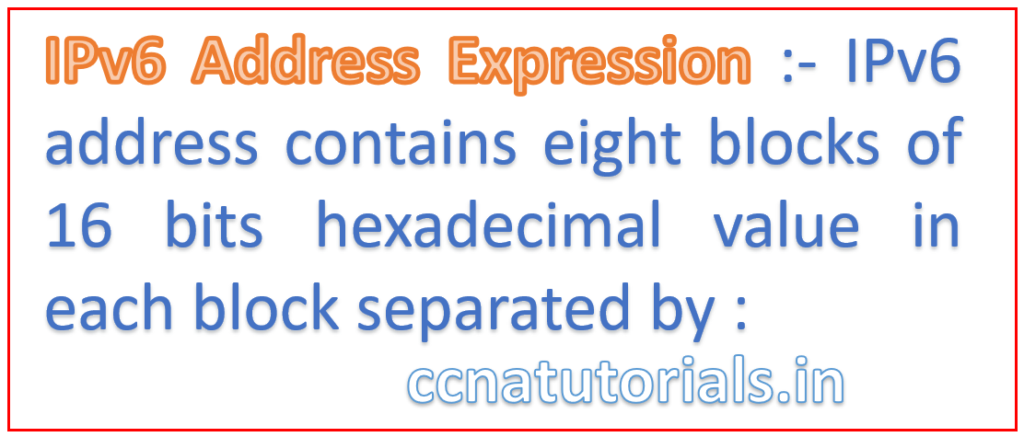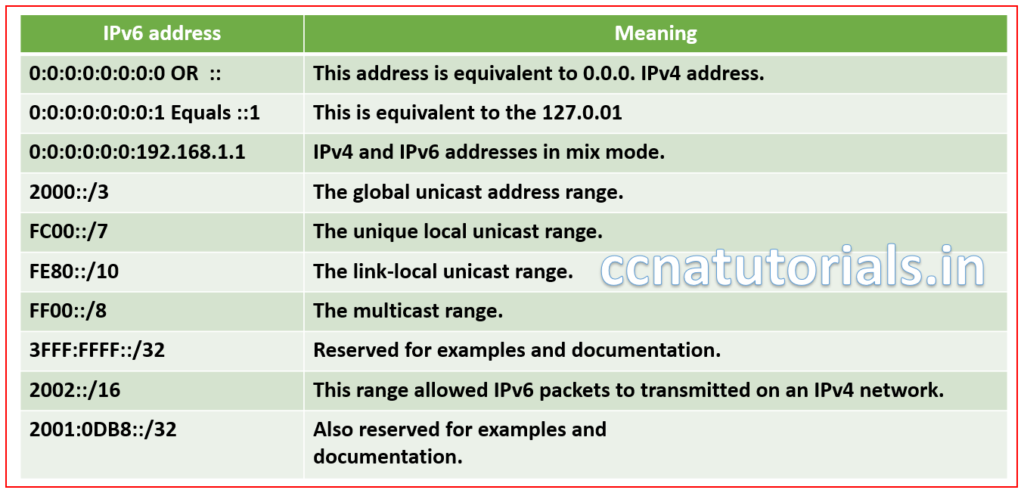Contents of this article
In this article I describe you the IPv6 address expression. Internet Protocol Version6 IPv6 is a type of internet protocol. We know about IPv4 and works with IPv4 for inter-networking and local networks. IPv4 address is a combination of 8 bytes or 32 bits. Every device connected in a network or internet required an unique IP address. There are billions devices which works on internet. IPv4 have limited IP addresses that is 232.
Which are not sufficient in today scenario. To overcome this problem Internet Protocol Version6 IPv6 invented by IETF team. IPv6 address is a combination of 128 bits. So we have now 2128 addresses to use in inter-networking or internet. The numbers of IPv6 are billions of billions. These address provides security better than IPv4. Later I describe the security concern in Internet Protocol Version 6 IPv6. The main purpose of using Internet Protocol Version 6 IPv6 is to increase the IP address for devices connected in internet.
Initially the IETF ( Internet Engineering Task Force) developed the internet protocol to provide the communication between devices in a network. IPv4 developed to provide the unique identity to the devices of network. Internet was used by the cooperative organizations in these days. But now every one need internet via mobile or computer. So the addresses provided by IPv4 become less than the users. To overcome this problem NAT technique used in routers.
In our previous articles I describes the NAT ( Network Address Translation). IPv6 is the perfect solution to overcome the sufficient address problem and eliminate the NAT technology. Internet Protocol Version6 IPv6 follows the IPv4 protocols and allow the devices to communicate with each other over internet. Internet Protocol Version6 IPv6 comes in 1998 for commercial use but the devices was not compatible with IPv6. But now all devices are compatible with IPv4 and IPv6.
Important factors about the Internet Protocol Version6 IPv6.
There are many special characteristics of Internet Protocol Version6 IPv6 presents over IPv4. The main thing about Internet Protocol Version6 IPv6 is the large numbers of address provided by IPv6. We can say the IP address increased from 232 to 2128. The IPv6 improves the packet transfer capacity of networking devices like router and switches. Internet Protocol Version 6 IPv6 provides the auto configuration of address like IPv4 but more efficiently.
IPv6 can handle a large packet payload comparison to IPv4. Identity of devices and data packets become more easy and efficient. Point to point communication efficiency of networking devices increased comparison to IPv4. Compatible for handy devices like mobiles and tabs. The main and important function of Internet Protocol Version 6 IPv6 is that it is compatible with IPv4 protocol. Means different devices used IPv6 and IPv4 can communicate with each other. It is known as Dual stacking in networking.
IPv6 Address Expression
IPv6 address length is 128 bits, we know the length or IPv4 is 32 bits. Expression of IPv4 is very easy because the IPv4 address used the decimal numbers for addressing. It is easy to configure the IP address with decimal figures. There was only 4 bytes in IPv4 but in IPv6 there are 8 section of hexadecimal format. IETF make it easy with some predefined rules for IPv6 address expression. IPv6 address expression means how to denote the IP address. As there are 8 sections of 16 bits each so it is very difficult to remember these addresses. Let’s see the special about the IPv6 address expression in networking.

See the above image, in this image the IPv6 address breaks into different sections. The first 36 bits known as Global prefix bits. next section of 16 bits is the subnet mask for that global prefix. The last 64 bits works for the interface ID of the connected device or network device. It is clear that the IPv6 have 8 groups of bits and the IPv4 have only 4 groups of bits.

How to write the IPv6 address?
It is very difficult to remember the IPv6 address because of its length and format. We can short the IPv6 address by following some tricks. There are some predefined rules for IPv6 address expression. First thing is that IPv6 address used the semicolon in place of dot as in IPv4 address. Remember the IPv4 address looks like 192.168.1.2. IPv6 address format replace the dot with semicolon. The IPv6 address looks like 3241:00BD:0000:A000:0000:0000:0101:0012 here the dots replaced with semicolon and each section is a hexadecimal figure. Our question was that how to write or remember the IPv6 address. Some predefined rules to shorten the addresses are below.

The first thing with IPv6 address is that you can eliminate the 0 from each section. After doing that the above IPv6 address look like 3241:BD:0:A:0:0:101:12. You see the modified address looks like easy than the original address.
The next rule to write the IPv6 address is you can eliminate the two consecutive 0’s by replacing with a double column. For example, the 0000:0000 can be written as :: . So, the example we have taken above can be written as 3241:BD:0:A::101:12. Now our IPv6 address become more short. These rules make it little bit easy to write the IPv6 address.
Example of IPv6 address expression
Lets take another example of IPv6 2111:0000:0000:0A11:243B:0000:0000:0001. By following the first rules to eliminate 0 with column symbol. The taken address can be written as 2111:0:0:A11:243B:0:0:1. The IPv6 address become short by applying the first rule. Now apply the second rule than the above address become more shorter like 2111::A11:243B::1 . now this address can easily written and remembered by some one.
I think It is enough to understanding the format if IPv6 address expression. I hope you enjoyed this article and understood the IPv6 address expression well. For any query or suggestion on this article contact us or drop a comment below.






